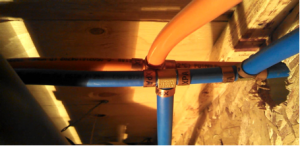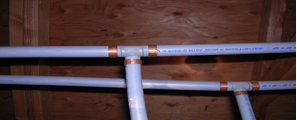Is it Time For New Pipes?
Home-Alyze brings us this great information about water line materials. Perhaps it can help you decide if it’s time for new pipes in your home.
In recent months, insurance companies have been asking their clients about the type of Pex piping in homes that were built from about 1995 to 2007. We have been helping our clients with this issue as some insurers are reluctant or refusing to insure homes with Kitec or the other brands it was sold under. Also included is some information on Poly-B water lines that was used from the early 1980’s to about 1998.
Kitec Water Pipes

Kitec water pipes were made from polyethylene and a thin inner layer of aluminum and have brass fittings. They are typically blue in color for cold water applications and orange or red in color for hot water applications. They can also be black or grey. The pipes were sold from about 1995 to 2007 under various brand names, including Kitec, PlumbBetter, IPEX AQUA, IPEX Homerite WARMRITE, Kitec XPA, AmbioComfort, XPA, KERR Controls and Plomberie Amelioree, PEX-AL-PEX. Where the brass fittings are visible the words Kitec, KTC or the terms CSA B137.9/10 or ATSM F1974 on them also indicate a Kitec system.
In 1995, IPEX recalled brass compression fittings from Canadian and U.S. distributors. The Canadian statement of claim alleged the fittings were faulty causing pipes to disintegrate. The brass fitting that apparently have a large percentage of zinc are reacted with the chemical composition of the liquid inside, causing them to corrode, or “dezincify,” fail or restrict the flow through the fittings. Kitec products were also used in some under floor radiant heating systems with similar results but they are usually easier to repair since there are usually less connectors and most are visible should a problem occur.
Running hot water through the lines has also been considered detrimental to their longevity. Keeping hot water settings as low as possible and keeping pressure as low as possible with the use of a pressure reduction valve is desirable for all plastic water systems.
There are class action lawsuits in Canada and the U.S. that allege that the product was negligently manufactured, which caused the pipes to disintegrate prematurely. Some insurance Companies have deemed these systems unreliable and may add a premium or refuse to cover them by insurance. Kitec may not be identified specifically during a typical home inspection.
Polybutylene (Poly-B) Domestic Water Lines

The use of Plastic Polybutylene Water Lines commonly referred to as Poly-B, began in the early 1980’s until about 1998. Initially there were very few problems with this material if it was properly installed with copper connectors and adequately supported. Over time however failures have occurred in some cases, sometimes in the form of small pinhole leaks and other times larger splits have occurred. There have been enough failures over the years for insurance companies to take notice and it is not uncommon for increased premiums or refusal to insure homes with Poly-B as the primary water line distribution material. It must also be stated that there are many thousands of homes that have this material used that have never had any failures.
Characteristics of Poly-B
- Poly-b is grey in color.
- Primarily used in residential construction.
- Failures tend to be more predominant in water lines carrying higher temperature water.
- The integrity of Poly-B Water Lines is believed to be compromised if exposed to ultra-violet light for any significant amount of time.
- The integrity of Poly-B Water Lines is also believed to be compromised if exposed to high levels of chlorine if added to the water.
So what’s my remedy?
- In most cases home owners are leaving Poly-B water lines in their homes and sharing the risk of a possible failure with their insurance company.
- It is considered a good upgrade to add a pressure reducing valve on the main water supply into the home to reduce the overall pressure the water lines need to endure.
- Keeping the water temperature of the hot water running through the lines as low as possible is also recommended by many plumbing contractors. This helps save energy as well
- Ensuring the water lines are secured into place and not exposed to damage is also important.
- If you plan any renovations it is highly recommended to remove Poly-B water lines and replace them with new water lines as they are exposed and even consider replacing all the Poly-B if possible.
- If Poly-B has been used for under floor heating a qualified Plumbing contractor should be retained to separate the Poly-B from any liquid running through a boiler and ensure the lines are not exposed to high temperature liquid.
For more information, you can visit

